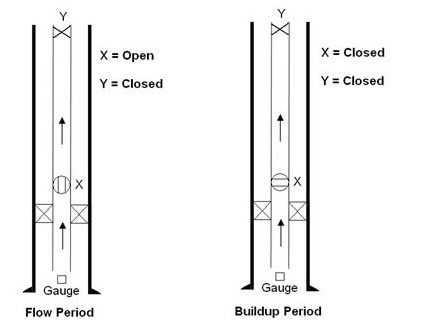Closed Chamber Inflow Test Type
A closed chamber test is a Perforation Inflow Test with a step-reduction in the wellbore volume at some point during the test. It is essentially equivalent to a drillstem test (DST) that is conducted with the wellhead valve closed, so that all formation fluid is accumulated in the wellbore and is not produced at surface. The figure below illustrates a typical wellbore configuration used to conduct a closed chamber test.

When applying this testing method to formations with moderate to high permeability (1 - 100 md), estimates of key reservoir properties (initial reservoir pressure (pi), permeability (k), and skin (s')) can be obtained without shutting in downhole, and resembles a perforation inflow test analysis (PITA). However, to obtain estimates of key reservoir properties in low permeability formations (< 1 md), downhole shut-in is required to reduce the wellbore volume (Vw) and decrease the time required to see reservoir-dominated (radial) flow. The downhole shut-in usually occurs after some formation fluid has been produced into the wellbore. Hence, this type of closed chamber test is comprised of two periods: a flow period when the wellbore volume (Vw) is large (PITA), and a buildup period when the wellbore volume (Vw) is small. To account for this reduction in wellbore storage, we have developed a different analysis technique, which is referred to as Closed Chamber Test (CCT) analysis.